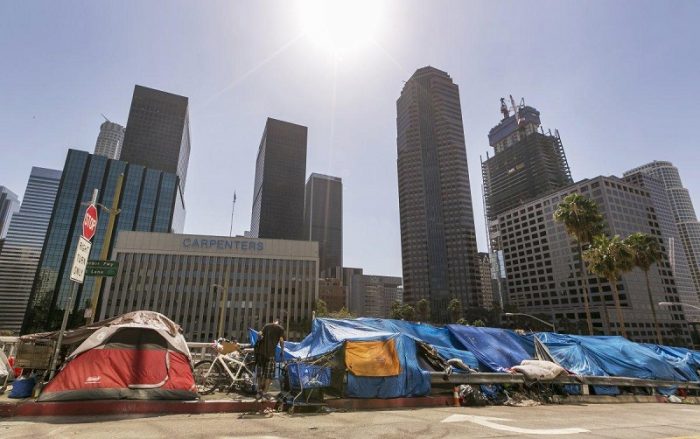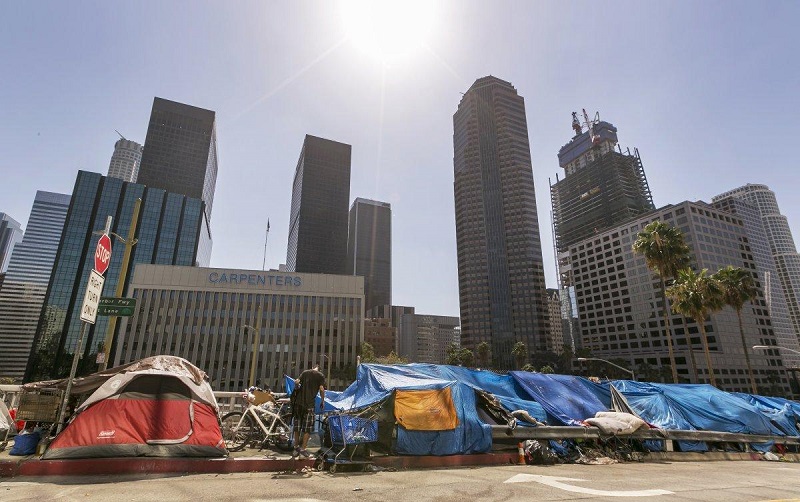
On Tuesday April 17, Mayor Eric Garcetti joined the City Council in declaring an emergency shelter crisis, and signed into law dual ordinances to help the city of Los Angeles pursue immediate, innovative solutions to the homelessness crisis.
Together, the Shelter Crisis Declaration, Permanent Supportive Housing Ordinance, and Interim Motel Conversion Ordinance will give the city unprecedented flexibility in erecting emergency shelters, streamlining affordable housing development, and using existing infrastructure to bring homeless Angelenos indoors more quickly.
“We’re fighting with everything we’ve got to put a roof over the head of unsheltered Angelenos,” said Mayor Garcetti. “The urgency of the homelessness crisis demands that we take every possible step to help people pack up tents and move indoors as quickly as possible.”
As Proposition HHH and Measure H dollars begin flowing and work ramps up to house more homeless Angelenos for good, the city is also focusing on the immediate need for safe spaces to sleep for people who are on the streets tonight. The ordinances signed into law today recognize this urgency, and put a broad array of tools at the city’s disposal.
Los Angeles is the first city in California to take advantage of a new state law that allows cities to build homeless shelters on any land owned or leased by the city. Previously, emergency shelters were limited to existing government owned or leased buildings. The new law also allows cities to adopt alternative, minimum public health and safety standards in order to stand up shelters quickly. Action taken by the City Council last year also allows the city to open shelters that operate year-round, instead of only during the winter months.
The Permanent Supportive Housing Ordinance will help shrink the pre-development timeline for many supportive housing developments from as many as five years to less than one — by creating a streamlined planning process and removing regulatory barriers that have historically impeded the approval and construction of supportive housing.
The Interim Motel Conversion Ordinance will allow existing motels and hotels to be retrofitted for use as supportive and bridge housing, and linked to County-funded services specifically designed to help homeless Angelenos begin to rebuild their lives.
“I applaud the Mayor and Council for taking a key step toward the permanent supportive housing so essential to our future and enacting a motel conversion ordinance to propel near-term homeless housing solutions forward,” said City Attorney Mike Feuer. “These actions, in collaboration with the county, show the potential when we join together to tackle our homeless crisis.”
“We must do everything possible to ensure the city has the infrastructure in place to battle homelessness,” said City Council President Herb Wesson. “These new policies continue the city’s track record of ensuring we are providing comprehensive solutions to a multifaceted challenge.”
“These ordinances are the latest example of the city of Los Angeles turning policy goals and program recommendations laid out in our Homelessness Strategic Plan into reality,” said Councilmember José Huizar, who led the effort on the City Council, along with Councilmember Marqueece Harris-Dawson, to adopt the PSH and Motel Conversion ordinances. “Once the Mayor signs them into law, nothing short of profound change will be possible for the men, women and children experiencing homelessness who will benefit from these programs. Our work continues, but we are making progress.”
“You are seeing a sustained commitment to a comprehensive and strategic approach to ending homelessness,” said Councilmember Marqueece Harris-Dawson. “Today we are cutting red tape and readapting problem motels to new housing. These are the kind of solutions we need to address the biggest challenge of our generation.”
During his annual State of the City address on Monday, Mayor Garcetti unveiled “A Bridge Home,” the next step in his work to end street homelessness over the next decade. The plan includes a $20 million Crisis and Bridge Housing Fund, set aside in the FY18-19 budget, which will be distributed evenly among Council Districts. In order to access the funds, each Councilmember must identify a site or building adjacent to a high-density homeless population and establish an emergency shelter.
In the months leading up to these new shelters opening, the county will direct unprecedented outreach, mental health, and addiction support services to encampments in participating districts, to prepare homeless Angelenos to move indoors. After the new shelters open their doors, City Sanitation teams will work to restore spaces that were previously encampment sites into safe, clean, public passageways.
The emergency shelters will stand for three years, enough time for the city to build supportive housing for the Angelenos living in them. The supportive housing will be furnished with on-site mental health, employment, addiction, and wellness resources.







